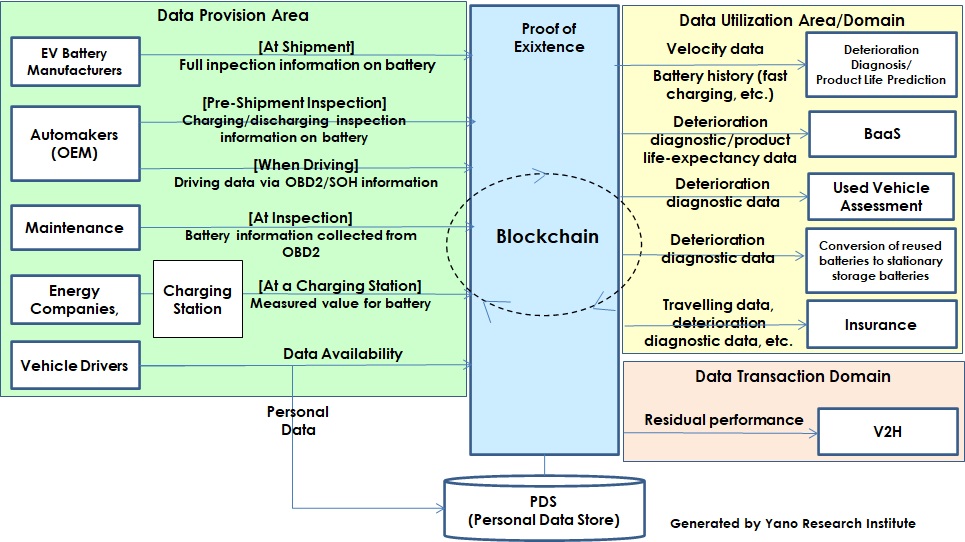No.3243
Potential of Blockchain Utilization for EV Batteries: Key Research Findings 2023
Hypothesis on Blockchain Utilization on Premise of Open EV Battery Data
Yano Research Institute (the President, Takashi Mizukoshi) carried out research on EV battery dataflows in the case of utilizing blockchain technology attracting attention for its traceability and suggested a hypothesis.

Summary of Research Findings
Those materials for electric vehicle (EV) batteries (in-vehicle battery packs incorporating cells and onboard chargers) are nickel, cobalt, graphite, or other rare metals, and are used as cathode materials. Because the provenance for such rare metals is located unevenly worldwide, stability and certainty of supplying such materials are said to be the challenge.
To improve this situation, there are moves to proactively establish a circular economy for EV batteries by tracking the materials from retrieving of rare metals from disposed electronic devices to repurposing or reusing them. As a solution to trace such rare metals from the moment they are extracted at mining site, and then are manufactured, sold, repurposed, and recycled, blockchain technology has started being used by many businesses including MOBI (Mobility Open Blockchain Initiative).
In such a situation, to understand the reasons for battery degradation, each of automakers accumulate information in their databases on EV battery consumption including the conditions when used, i.e., the environmental and charging/discharging conditions, thereby to evaluate the deterioration statuses. However, such measured data includes information on driving histories, which is making it difficult to disclose from the aspect of securing personal data.
Regarding the broken automobile data, while the reasons and inspection items are currently detected and confirmed from electronic control data retrieved by an OBD2 (onboard diagnostics) device at a maintenance facility, as automakers provide the affiliate dealers their unique, in-house measuring tools, the tools used for maintenance differ by each automaker. On the other hand, as non-Japanese automakers do not have their own maintenance facilities in Japan, maintenance work is done at any maintenance facilities available to respond to the request, using general-purpose measurement tool.
Noteworthy Topics
In such closed conditions by each automaker, this research suggests a hypothesis on how blockchain contributes to EV battery data on the supposition that EV battery data is to become open.
The diagram created in this research positions a blockchain in the center, with Data Provision area placed on the left side and Data Utilization area on the right. In the Data Provision area, there are EV battery manufacturers, automakers (OEM), maintenance facilities, charging station operators, etc., which are presumed to provide the following data to the blockchain:
Main data considered to be registered are:
1) EV battery manufacturers: Charging and discharging data at shipment inspection.
2) Automakers: Charging and discharging data at receiving inspection or pre-shipment inspection, and EV battery data when driving, and SOH (state of health) information.
3) Maintenance facilities: Data pertaining to repair work
4) Charging stations: Residual data for EV batteries
The area on the right is where the data registered to be utilized, and can further be categorized into Data Utilization domain and Data Transaction domain. At Data Utilization domain, deterioration diagnostic information and product life-expectancy predictions can be used extensively for BaaS (Battery as a Service), assessment of used vehicles, use of repurposed batteries, insurance, and V2H (Vehicle to Home), based on the diagnostic results and product lifetime information. Regarding data utilization, as EV batteries can be a huge differentiation factor for automakers, it is better to add browsing rights to prevent browsing among competitors.
Data Transaction domain is expected to become important. In general, electricity stored at EV batteries can be connected to household panelboard, after which it is then generally available for lighting, household appliances, etc. In the future, by transacting the data on consumption statuses for stored energy (electricity), excess electricity may not only be consumed at limited environment such as at home but may also be available for EV charging at a charging station when traveling outside with an EV.
*BaaS refers to the scheme that lets EV users to exchange batteries at battery exchange stations rather than owning EV batteries.
Research Outline
2.Research Object: Businesses that involve in IT, blockchain, measuring, auctions for used products, etc.
3.Research Methogology: Face-to-face interviews (including online) by expert researchers, surveys via telephone and email, online consumer survey, and literature research.
Potential of Utilizing Blockchain for EV Batteries
This research suggests a hypothesis for utilizing attention-attracting blockchain technology for its traceability to contribute to recycling electric vehicle (EV) batteries on the premise of data can be open.
A blockchain is the scheme that records and certifies the transactions such as transfer of rights by utilizing P2P (peer-to-peer) network, where each node (peer) connects to one another. As blockchain does not allow tampering, which guarantees authenticity, no data recorded can be erased. Use of Such a property realizes traceability and achieves transparency in transactions. This is why it is used in industries for finance and distribution. Blockchain is also said to be effective when wanting to share data across multiple organizations in the tamper-proof form. It can limit users to browse when sharing data.
Published Report
Contact Us
The copyright and all other rights pertaining to this report belong to Yano Research Institute.
Please contact our PR team when quoting the report contents for the purpose other than media coverage.
Depending on the purpose of using our report, we may ask you to present your sentences for confirmation beforehand.